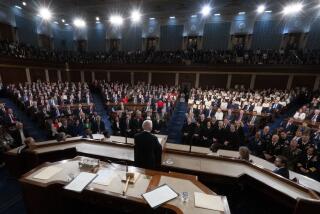McManus: Your guide to the ‘fiscal cliff’

Are we about to go over a fiscal cliff? It’s looking more likely, but it may not be as alarming as it sounds.
Here are three things you need to know about the impending crisis over the so-called fiscal cliff, the combination of tax increases and automatic spending cuts due to kick in at the turn of the year:
First, it’s not really a cliff; it’s merely a steep, scary slope. If Congress doesn’t act, federal taxes will increase by more than $500 billion next year and federal spending will be cut by about $200 billion. The impact would be equivalent to subtracting about 4% of gross domestic product, enough to push the economy into recession.
But that’s not going to happen — at least, not abruptly. The tax increases scheduled for the first of the year can be delayed either by a stopgap act of Congress or by a stroke of Timothy F. Geithner’s pen. (The Treasury secretary can simply postpone any change in tax withholding until a deal is made.) Spending cuts can be slowed down as well. So if Congress fails to make a deal by Christmas, that doesn’t mean the economy automatically tips into a recession.
Congress knows that, which is why almost nobody in Washington expects a comprehensive agreement on taxes and spending to be concluded in the next two weeks. When have we ever seen Congress make a deal before its back was against the wall?
That’s why President Obama called for a stopgap bill — “a down payment” — in an interview Tuesday with Bloomberg Television.
In Washington, an optimist is someone who thinks Congress will find an orderly way to postpone real negotiations until January. A pessimist is someone who agrees that the negotiations will be postponed, but in a chaotic way that sets off panic in the financial markets. And a realist is someone who thinks a little panic is needed to give each side an excuse to compromise on deeply felt fiscal principles.
Second fact: The Democrats have the upper hand. They just won a presidential election, plus two additional seats in the Senate, plus a handful of seats in the House. The issue of tax rates was the clearest choice presented to the voters, and most of them favored Obama’s plan to raise tax rates on the wealthy.
House Speaker John A. Boehner (R-Ohio) and his colleagues dismissed the outcome as “a status quo election” in their letter to Obama on Monday, but that was whistling past the graveyard. A Pew Research/Washington Post poll released Tuesday found that a solid majority of Americans say they will blame Republicans if an agreement is not reached.
“The testosterone levels on the Republican side are dramatically lower” than before the election, said Charlie Cook, Washington’s preeminent analyst of congressional anthropology.
Some Republicans are reluctantly admitting that they will have to accept higher tax rates on upper-income households as the price of even a stopgap deal. But the proposition divides the party deeply because it requires a break from the doctrine of ever-lower taxes that has defined the GOP for 20 years or more.
Needless to say, Democrats have been enjoying the spectacle of Republican disunity. Obama insists the increase in tax rates is “a matter of math,” but his tough line is also serving a political purpose, driving a wedge into the ranks of his opponents.
So far, Democrats have managed to duck tough decisions on how much to cut from Medicare, Medicaid and Social Security. Their day of reckoning will come, but probably not until next year.
Third fact: It may not be apparent, but progress is being made.
When Obama issued his initial proposal last week for $1.6 trillion in tax increases, $350 billion in healthcare spending cuts and
$50 billion in new stimulus spending over 10 years, Boehner dismissed it as “non-serious.” He was right, in the sense that Obama didn’t take a significant step toward the middle; it was merely an opening bid.
Boehner’s counterproposal Monday was equally unserious. The Republicans proposed that federal revenue should rise by $800 billion, half of Obama’s figure, but without raising tax rates. They also proposed spending cuts twice as big as Obama’s. In short, it was another opening bid.
But it was signed by the leaders of the GOP’s conservative faction, Reps. Eric Cantor (R-Va.) and Paul D. Ryan (R-Wis.). In 2011, when Boehner tried to cut a deal with Obama that would have included $800 billion in new revenue, Cantor and Ryan never clearly signed on.
With the ball back in Obama’s court, the president offered on Tuesday to meet somewhere in the middle, just as long as Republicans agree to some increase in tax rates.
“I recognize that I’m not going to get 100%,” Obama said in his Bloomberg interview. “I’m happy to be flexible.”
He was asked whether he would insist on the top tax rate returning to the Clinton-era level of 39.6%, and carefully ducked the question — meaning, no. He agreed that Republicans are right to insist on specific cuts in spending on Medicare and Medicaid, not just vague promises of future cuts. And he left the door open to raising the Medicare eligibility age from 65 to 67, which is anathema to many liberals.
This is not the outline of a deal — not yet. But as Erskine Bowles, the author of another compromise plan, said this week, “Every offer put forward brings us closer to a deal.”
Follow Doyle McManus on Twitter @DoyleMcManus
More to Read
A cure for the common opinion
Get thought-provoking perspectives with our weekly newsletter.
You may occasionally receive promotional content from the Los Angeles Times.











